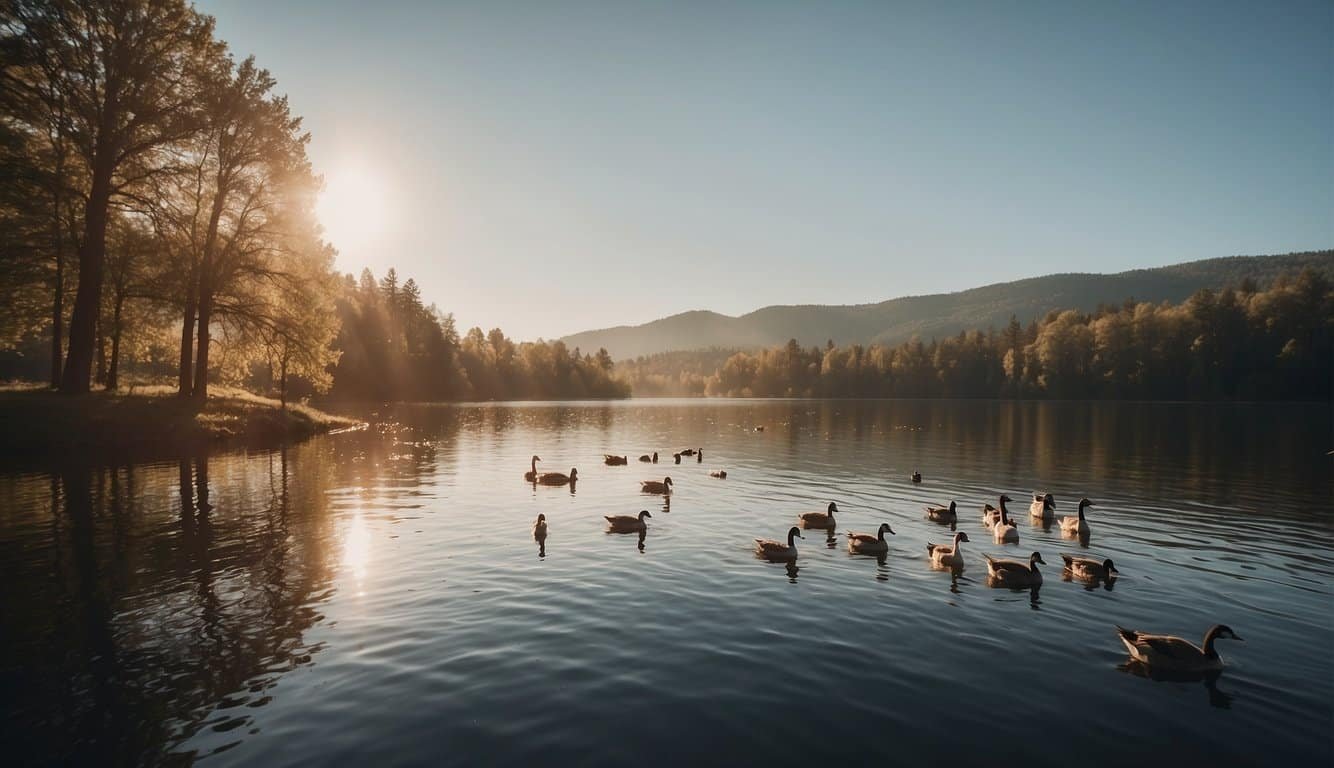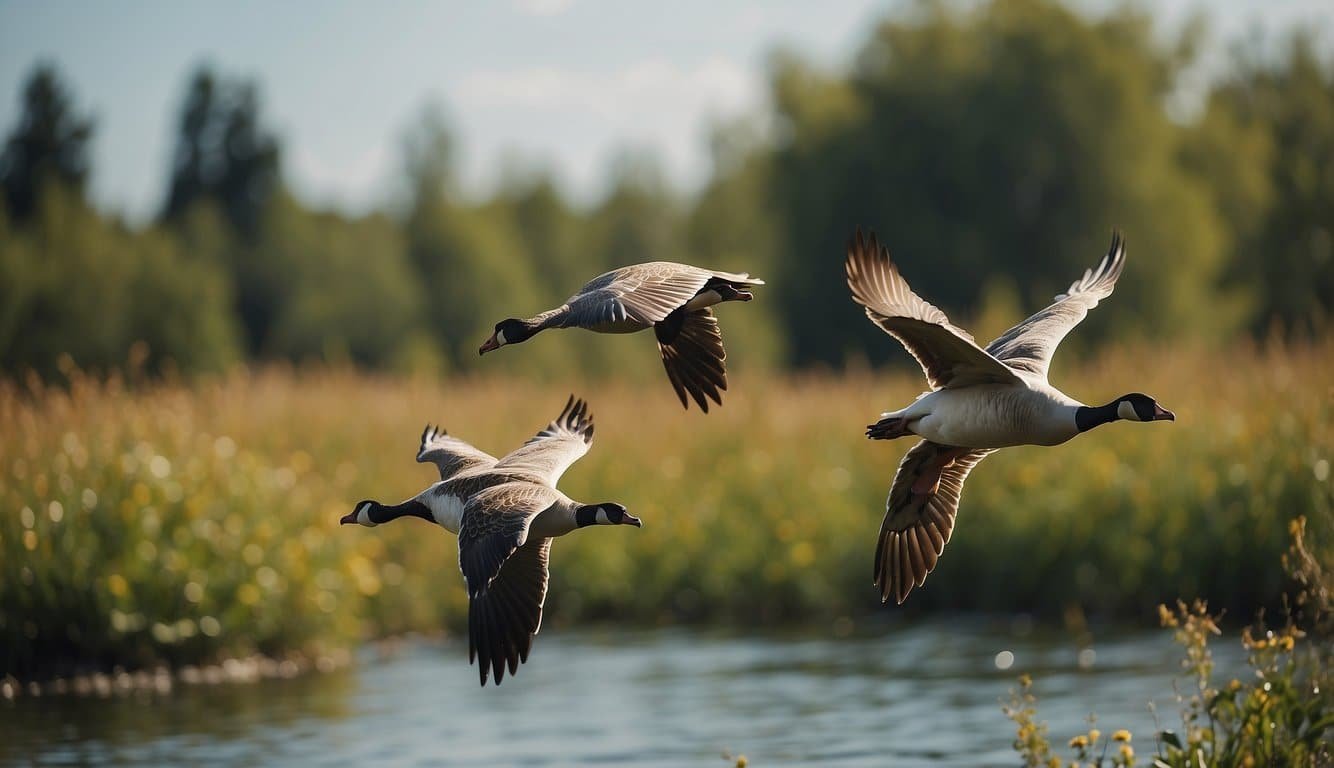Introduction to Geese
Geese are fascinating waterfowl known for their distinctive honk and ability to fly in a V-formation. They belong to the family Anatidae, which includes other waterfowl like ducks and swans. These birds are adaptable to various habitats across the globe and have significant cultural and ecological importance.
Physical Characteristics
Geese stand out with their long necks and plump bodies, often showcasing white or black feathers that contribute to their striking appearance. Species of geese vary in size; some have shorter necks and legs, while others display impressively long necks suited for grazing. Their feathers provide not only a distinctive coloration but also essential waterproofing for life on the water.
Behavior and Habitat
These birds are highly social and often found in flocks, referred to as a ‘gaggle’ on land or a ‘skein’, ‘team’, or ‘V-formation’ during migration. Geese are adaptable, inhabiting continents ranging from North America to Europe and Asia, with some species found in Africa and Australia. Their preferred habitats are freshwater environments like lakes, ponds, and rivers.
Diet and Feeding Habits
A goose’s diet consists primarily of grasses, sedges, and aquatic plants. In search of food, they can often be seen grazing in fields or tipping up in the water to reach plants. Additionally, they’ll occasionally include insects in their diet. Domestic geese, introduced by humans, might have varying diets depending on their managed care environments.
For more information about geese introduced by human interaction, you can read about Naturalised geese in Europe. To understand better the threats that geese can face in a domestic setting, including diseases like West Nile virus, explore this detailed account of an outbreak among domestic geese. Further insights into the nutritional content of goose products can be found in this research on goose production and goose products. To delve into the colorful life of these birds in the wild, the book “Wild geese” offers an engrossing read.
Geese in Human Culture

Geese have been woven into the fabric of human culture across various civilizations. They appear in folklore, video games, and even our everyday language, indicating their significance beyond just being an animal raised for their meat and down.
- Folklore and Nursery Rhymes: The term “Mother Goose” brings to mind a plethora of nursery rhymes that have been passed through generations. This fictional character is often depicted as a kindly old woman who tells stories and sings songs to children.
- Idioms and Sayings: Terms like “silly goose” reflect how geese are perceived in society—as clumsy or foolish. The idiom “killing the goose that lays the golden eggs” warns against shortsighted actions that destroy valuable resources.
- Video Games: The “Untitled Goose Game” gained popularity for its playful approach to gameplay, where players control a goose causing mischief in an unsuspecting village.
- Domestication and Utility: Geese have been domesticated for their contributions to farming and food. They serve as pets, guardians of property, and producers of down for insulation. Geese also play a role in cultural dishes and celebrations around the world.
Each of these points illustrates the diverse roles that geese play in human life and language. From the humorous escapades in a digital world to the lessons they impart through age-old proverbs, geese continue to flap their wings prominently within the tapestry of human expression.
Conservation and Species

Conservation efforts for geese species span the globe, focusing on both wild and domesticated populations. Geese, known to be migratory birds, traverse vast distances, which makes their conservation a matter of international importance.
For instance, the Greylag Goose has seen mixed conservation status. They are considered the ancestors of most domesticated goose breeds. While some populations are stable or increasing, others, particularly migratory flocks, require monitoring and conservation action.
Snow Geese experience a different sort of challenge. Their booming numbers due to successful conservation efforts have led to overpopulation in certain areas, causing habitat destruction and the need for population management strategies. The discussion around these geese can be found in an article from Cambridge, which notes the economic perspective on wild goose management.
Meanwhile, the Canada Goose, often recognized for their V-shaped migratory patterns, have adapted well to human-altered environments, leading to them becoming a common sight in many North American regions.
The Brant or Brent Goose faces habitat threats due to coastal development and climate change. Conservation programs focus on habitat protection to ensure their survival.
Rare species like the Nene, also known as the Hawaiian Goose, have made remarkable comebacks from the brink of extinction, thanks to intensive conservation efforts including captive breeding programs.
The Greater White-Fronted Goose has healthy populations due to adequate habitat preservation, while the Magpie Goose and Cape Barren Goose have conservation programs in place to monitor and manage their numbers.
As for Swan Geese, efforts in their native regions aim to uphold their numbers, facing threats from hunting and habitat loss.
In Poland, the state of goose genetic resources conservation is documented, highlighting the importance of maintaining diverse goose breeds not only for biodiversity but also for cultural heritage.
Conservation is a multi-faceted approach that not only addresses immediate threats but also plans for the long-term sustainability of species, considering factors like climate change and human interference, to ensure that these charismatic migratory birds continue to grace our skies and landscapes.

